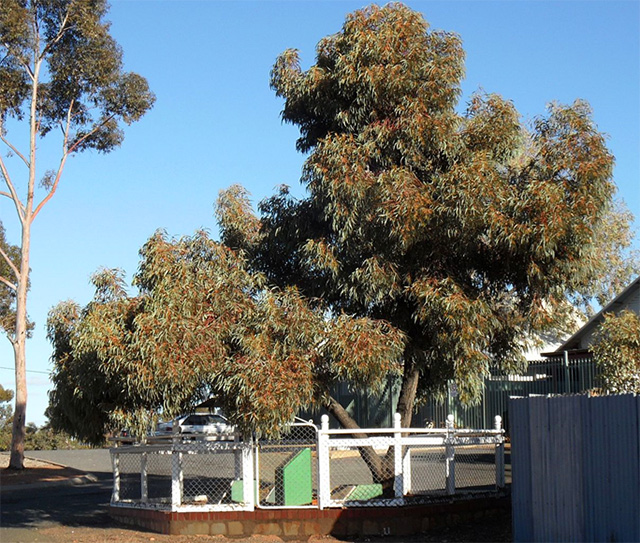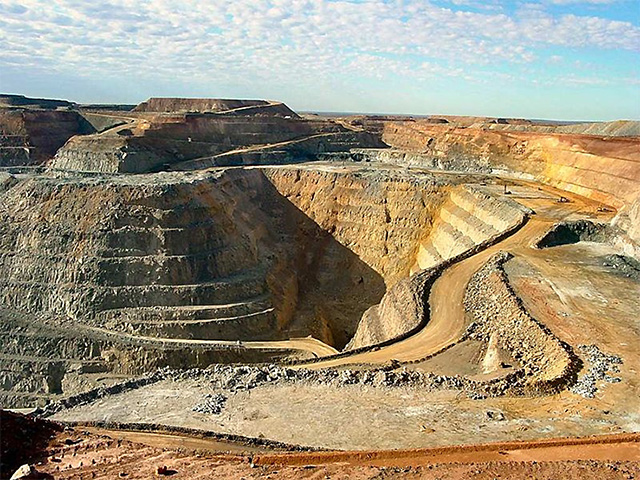
Opinions are divided on eucalyptus trees. In some places, they’re a fast-growing cash crop. In others, they’re an invasive species.
In Australia, where the trees originate, they’re about to become more popular because they may lead miners to gold.
In Australia’s dry climate, eucalypts send roots down hundreds of feet looking for water.
In gold mining areas, scientists have found microscopic gold flakes, thinner than a human hair, in the tissues of their leaves and on the waxy residue that coats them.
They wondered if blowing dust could have carried gold particles onto the trees or if perhaps their deep roots could have drawn up trace amounts from far below the surface.
They conducted experiments, growing eucalypts in sterile environments, giving them gold-laced water. And sure enough, gold appeared in the foliage.
They realized that the gold is probably toxic to the trees, which send it out to their leaves where it can be shed.
The scientists analyzed eucalyptus trees in other parts of Australia but found very little gold. Clearly, trees in gold-rich regions were mining it themselves!
Before we get too excited about processing eucalyptus leaves for gold, it would take 100 trees to produce enough for a wedding band.
Scientists do believe, however, that searching for trace amounts in eucalyptus leaves could be a low-impact way of prospecting for gold in the future.
Background
Synopsis: In the 1890s, thousands of prospectors searched for gold and precious metals in Australia’s remote Outback. Many failed, but in 1893, three very lucky men found hints of gold in Western Australia that turned into one of the biggest mines on Earth. Today there is an amazing new low-impact way to prospect in the region, using eucalyptus tree leaves. “There’s gold in them thar trees!”
- June 14, 1893, was a very lucky winter day for Irish immigrants Patrick Hannan, Tom Flanagan and Dan Shea, on the search for gold in Western Australia.

Super Pit near Kalgoorlie, Australia, is Patrick Hannan’s mine from the 1893 find. Credit: By Brian Voon Yee Yap at English Wikipedia [CC BY-SA 4.0 https://creativecommons.org/licenses/by-sa/4.0)] - It didn’t start out so well. One of their horses threw a shoe, so they had to stop to re-shoe it. While wandering around the area, they found signs of gold in a gully.
- Paddy Hannan staked the claim on June 17, and within a week, a stampede of more than 1,000 miners arrived, starting a major gold rush in the area, which is known as the Golden Mile.
- The present-day town of Kalgoorlie developed nearby to support the miners.
- The modern mine is a huge open-cut mine known as the Super Pit—the fourth-largest gold mine on Earth today—with continuous operations for more than 100 years. Ownership is shared by Barrick Gold and Newmont Mining.
- By 2018, the mine had produced more than 19.5 tons (628,000 troy ounces) of gold, worth about $950 million today.
- It is 2 mi (3.5 km) long, 1 mi (1.5 km) wide and close to 2,000 ft (more than 600 m) deep and employs 1,100 people.
- Today, a large eucalyptus tree and commemorative plaques mark the site of the original find—a very lucky discovery indeed!
- Eucalyptus is a distinctive genus of flowering trees with more than 700 species that are native to Australia.
- About 75 percent of Australian forests are eucalypt forests.
- Eucalypts are drought-resistant and very fast growing—up to 2.5 in (10 cm) per day when young—so are farmed on plantations around the world for their soft timber and pulpwood.
- Many eucalypts are adapted for the frequent wildfires of the Australian Outback and will re-sprout from stumps or have seeds that survive flames.
- Because they can grow in very arid regions, some eucalypts develop root systems that may be hundreds of feet deep to access groundwater.
- Commercial gold deposits are notoriously hard to find and evaluate, but recently researchers have discovered an amazing fact that will lead to lower-impact exploration. Money may not grow on trees, but gold does!
- The long, deep roots of eucalyptus trees have been found to draw trace quantities of gold into the tree from up to 110 ft (33 m) below Earth’s surface.
- Scientists have found tiny nuggets—the largest of which are just 8 µm across (20% of the thickness of a human hair)—within leaf tissues and gummy substances coating the leaves of trees that grow above gold deposits in the Goldfields-Esperance region of Western Australia, near Kalgoorlie.
- In 1900, inventor Emil Lungwitz reported that plants can accumulate gold and other precious metals, but scientists didn’t know whether the gold came from the soil or from dust in the air.
- To be sure that the gold was sourced from below the ground instead of from dust blowing in the air, researchers recently tested the hypotheses in a lab. They grew eucalypts in an airborne-dust-free environment using gold-enriched watering solutions and soils, and gold appeared in and on those leaves.
- It is no surprise that plants absorb the entire palette of minerals available from the soil they grow in. But particulate metallic gold is probably toxic to them, explaining why it would be concentrated primarily in the leaves—the tree’s extremities—to reduce any adverse biochemical effects to the tree as a whole. Trees shed leaves, removing toxic materials from their systems.
- Researchers documented that eucalypts growing in areas without gold deposits had leaves that contained about 2 parts per billion (ppb) gold, while those growing above a gold deposit had leaves containing up to 40 times more gold (80ppb).
- The trees also concentrate copper and zinc.
- If you are thinking about mining the trees for their gold, think again. It would take hundreds of trees to produce enough gold to make a single wedding band.
- In the elusive hunt for gold deposits, however, any new exploration method that creates no environmental impact in regions where deep-rooted trees like eucalypts grow will enable inexpensive prospecting. Maybe money does grow on these trees after all!

